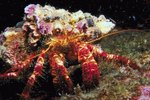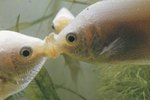
Crayfish can be great alternatives -- or additions -- to fish when you're setting up a tank. They are small -- some as little as 2 inches -- and very easy to keep. Best of all, they are a lot of fun to watch as they go about their business, walking around searching for food or just exploring their surroundings. Because they are so easy to take care of and require little attention, they make ideal pets for kids or those who don't want to spend too much taking care of a pet.
Step 1
Set up the tank properly. Crayfish need a tank with fresh water that's kept clean and free of pollution. A filter is a must and so is a heater if you live in a cold climate -- the water should be between 70 and 75 degrees. Check the pH level of the water regularly to ensure it stays around 7.0.
Step 2
Add some hiding space for your crayfish. This is especially important if you have several crayfish in the same tank -- where each of them might need some "alone time" once in awhile to avoid fights. Pipes, rocks that are arched -- and allow crayfish to crawl under -- or special plastic containers or igloo-like houses. Simply place this on the bottom of the tank.
Step 3
Get shrimp pellets for easy feeding and complete nutrition. Crayfish also will eat algae, dried seaweed, flake food -- the kind fed to fish -- and bloodworms or dried squid. Mix plant-based foods as the main source of nutrients and add some animal protein as an extra or complement.
Step 4
Get a second tank setup for crayfish that are molting. Molting is a process where the crayfish shed their shell or exoskeleton. During the molting process, the body of a crayfish is soft and vulnerable -- and this might incite other crayfish in the tank to attack. When the molting process starts -- usually indicated by the fact that your crayfish will stop eating -- simply move it to a different tank and leave him alone until it happens. If you have just one crayfish, then just leave him alone and watch the process happen.
References
Tips
- Make sure the tank is tall -- at least as tall as your crayfish is long -- to avoid potential escapes. Getting a lid for the tank is another option.
Photo Credits
-
Hemera Technologies/PhotoObjects.net/Getty Images
Writer Bio
Tammy Dray has been writing since 1996. She specializes in health, wellness and travel topics and has credits in various publications including Woman's Day, Marie Claire, Adirondack Life and Self. She is also a seasoned independent traveler and a certified personal trainer and nutrition consultant. Dray is pursuing a criminal justice degree at Penn Foster College.




